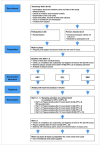Antibacterial Action, Substantivity and Anti-plaque Effect of Different Toothpaste Slurries - A Randomised Controlled Trial
- PMID: 34673844
- PMCID: PMC11641472
- DOI: 10.3290/j.ohpd.b2182977
Antibacterial Action, Substantivity and Anti-plaque Effect of Different Toothpaste Slurries - A Randomised Controlled Trial
Abstract
Purpose: This single-center, clinically controlled, double-blinded, randomised, crossover study aimed to evaluate and compare the antibacterial effect, substantivity and patients' acceptance of three toothpaste slurries after a single application on established biofilms observed for 24 h.
Materials and methods: Twenty-four participants started a test cycle after refraining from oral hygiene for 48 h, with a baseline plaque sample measuring biofilm vitality (in %; VF0) using vital fluorescence (VF). They were instructed to rinse for 1 min with either an amine fluoride, stannous chloride (ASC), an herbal (SBC) or a sodium fluoride (SFL) toothpaste prepared as slurries. Every two hours up to 12 and after 24 h, plaque samples were harvested (VF2-VF24%). Plaque-covered areas (PA in %) were evaluated after 24 h using digital photographs. Patients' acceptance was determined by visual analogue scale (VAS) questionnaire.
Results: All participants (16 women, 8 men; 27.5 ± 7.9 years) completed all cycles. Two hours after application (VF2), all toothpastes showed a statistically significant reduction in bacterial vitality (p < 0.05), maintained up to 12 h. ASC revealed statistically significantly lower vitality values compared to SBC at VF2, VF4, VF8, VF12 and VF24, and at VF4, VF12 and VF24 compared to SFL (p < 0.05), while SBC and SFL did not differ statistically significantly at any time point. The preferred toothpastes were SFL (18/24 participants) and ASC (15/24 participants).
Conclusions: All toothpastes showed statistically significant anti-plaque effects on established plaque biofilm and a substantivity up to 24 h compared to their baseline, while ASC still presented a statistically significant effect after 12 and 24 h compared to SBC and SFL.
Keywords: anti-plaque agents; biofilm vitality; chemical plaque control; substantivity; toothpaste.
Figures
Similar articles
-
Antibacterial Effect and Substantivity of Toothpaste Slurries In Vivo.Oral Health Prev Dent. 2018;16(2):175-181. doi: 10.3290/j.ohpd.a40310. Oral Health Prev Dent. 2018. PMID: 29736497 Clinical Trial.
-
Antibacterial effect of two toothpastes following a single brushing.Oral Health Prev Dent. 2007;5(1):25-32. Oral Health Prev Dent. 2007. PMID: 17366758 Clinical Trial.
-
Substantivity of toothpaste slurries and their effect on reestablishment of the dental biofilm.J Clin Periodontol. 2002 Jul;29(7):615-21. doi: 10.1034/j.1600-051x.2002.290705.x. J Clin Periodontol. 2002. PMID: 12354086 Clinical Trial.
-
Effectiveness of herbal oral care products in reducing dental plaque & gingivitis - a systematic review and meta-analysis.BMC Complement Med Ther. 2020 Feb 11;20(1):43. doi: 10.1186/s12906-020-2812-1. BMC Complement Med Ther. 2020. PMID: 32046707 Free PMC article.
-
Antiplaque and antigingivitis toothpastes.Monogr Oral Sci. 2013;23:27-44. doi: 10.1159/000350465. Epub 2013 Jun 28. Monogr Oral Sci. 2013. PMID: 23817058 Review.
Cited by
-
Stannous Source in Toothpastes Leads to Differences in Their Antimicrobial Efficacy.Oral Health Prev Dent. 2023 Sep 22;21:319-324. doi: 10.3290/j.ohpd.b4424911. Oral Health Prev Dent. 2023. PMID: 37737308 Free PMC article.
-
Herbal Dentifrices for Prevention of Dental Caries in Children and Adolescents: A Systematic Review.Int J Clin Pediatr Dent. 2024 Feb;17(2):229-236. doi: 10.5005/jp-journals-10005-2780. Int J Clin Pediatr Dent. 2024. PMID: 39184893 Free PMC article. Review.
-
In vitro evaluation of a novel fluoride-coated clear aligner with antibacterial and enamel remineralization abilities.Clin Oral Investig. 2023 Oct;27(10):6027-6042. doi: 10.1007/s00784-023-05216-7. Epub 2023 Aug 24. Clin Oral Investig. 2023. PMID: 37620439
References
-
- Addy M, Greenman J, Renton-Harper P, Newcombe R, Doherty F. Studies on stannous fluoride toothpaste and gel (2). Effects on salivary bacterial counts and plaque regrowth in vivo. J Clin Periodontol. 1997;24:86–91. - PubMed
-
- Addy M, Jenkins S, Newcombe R. The effect of some chlorhexidine-containing mouthrinses on salivary bacterial counts. J Clin Periodontol. 1991;18:90–93. - PubMed
-
- Addy M, Jenkins S, Newcombe R. The effect of triclosan, stannous fluoride and chlorhexidine products on: (I) Plaque regrowth over a 4-day period. J Clin Periodontol. 1990;17:693–697. - PubMed
-
- Addy M, Willis L, Moran J. Effect of toothpaste rinses compared with chlorhexidine on plaque formation during a 4-day period. J Clin Periodontol. 1983;10:89–99. - PubMed
-
- Armitage GC. Development of a classification system for periodontal diseases and conditions. Ann Periodontol. 1999;4:1–6. - PubMed
Publication types
MeSH terms
Substances
LinkOut - more resources
Full Text Sources
Miscellaneous


